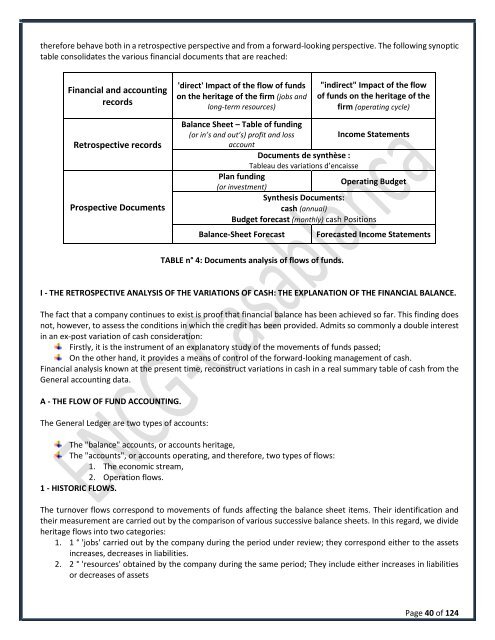Optmization of Treasury
This book is dedicated to companies and students that wish to know about how to optimize treasury and Cash-Management.
This book is dedicated to companies and students that wish to know about how to optimize treasury and Cash-Management.
Create successful ePaper yourself
Turn your PDF publications into a flip-book with our unique Google optimized e-Paper software.
therefore behave both in a retrospective perspective and from a forward-looking perspective. The following synoptic<br />
table consolidates the various financial documents that are reached:<br />
Financial and accounting<br />
records<br />
'direct' Impact <strong>of</strong> the flow <strong>of</strong> funds<br />
on the heritage <strong>of</strong> the firm (jobs and<br />
long-term resources)<br />
"indirect" Impact <strong>of</strong> the flow<br />
<strong>of</strong> funds on the heritage <strong>of</strong> the<br />
firm (operating cycle)<br />
Retrospective records<br />
Prospective Documents<br />
Balance Sheet – Table <strong>of</strong> funding<br />
(or in’s and out’s) pr<strong>of</strong>it and loss<br />
Income Statements<br />
account<br />
Documents de synthèse :<br />
Tableau des variations d’encaisse<br />
Plan funding<br />
Operating Budget<br />
(or investment)<br />
Synthesis Documents:<br />
cash (annual)<br />
Budget forecast (monthly) cash Positions<br />
Balance-Sheet Forecast<br />
Forecasted Income Statements<br />
TABLE n° 4: Documents analysis <strong>of</strong> flows <strong>of</strong> funds.<br />
I - THE RETROSPECTIVE ANALYSIS OF THE VARIATIONS OF CASH: THE EXPLANATION OF THE FINANCIAL BALANCE.<br />
The fact that a company continues to exist is pro<strong>of</strong> that financial balance has been achieved so far. This finding does<br />
not, however, to assess the conditions in which the credit has been provided. Admits so commonly a double interest<br />
in an ex-post variation <strong>of</strong> cash consideration:<br />
Firstly, it is the instrument <strong>of</strong> an explanatory study <strong>of</strong> the movements <strong>of</strong> funds passed;<br />
On the other hand, it provides a means <strong>of</strong> control <strong>of</strong> the forward-looking management <strong>of</strong> cash.<br />
Financial analysis known at the present time, reconstruct variations in cash in a real summary table <strong>of</strong> cash from the<br />
General accounting data.<br />
A - THE FLOW OF FUND ACCOUNTING.<br />
The General Ledger are two types <strong>of</strong> accounts:<br />
The "balance" accounts, or accounts heritage,<br />
The "accounts", or accounts operating, and therefore, two types <strong>of</strong> flows:<br />
1. The economic stream,<br />
2. Operation flows.<br />
1 - HISTORIC FLOWS.<br />
The turnover flows correspond to movements <strong>of</strong> funds affecting the balance sheet items. Their identification and<br />
their measurement are carried out by the comparison <strong>of</strong> various successive balance sheets. In this regard, we divide<br />
heritage flows into two categories:<br />
1. 1 ° 'jobs' carried out by the company during the period under review; they correspond either to the assets<br />
increases, decreases in liabilities.<br />
2. 2 ° 'resources' obtained by the company during the same period; They include either increases in liabilities<br />
or decreases <strong>of</strong> assets<br />
Page 40 <strong>of</strong> 124


